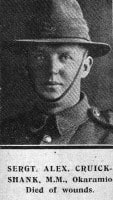6/2105 ~ ALEXANDER CRUICKSHANK, M.M.

David’s older brother Alexander (Sandy) however would suffer a different fate. The fact that he is remembered on the Maheno War Memorial (the town of his birth) in the Waitaki says it all, but his death was definitely not without honour.
Alexander and David were born in 1894 and 1896 respectively, the sons of Scottish farming parents John and Barbara Cruickshank. Alexander and David both worked as a farm labourers and both had served in the 12th Nelson (Territorial) Regiment being called up for full time war service. Alexander was first to depart overseas, with the 5th Reinforcements of the Canterbury Infantry Regiment in February 1915.
6/2105 Sgt. Alexander Cruickshank embarked for Egypt in June of 1915 and by August was in the thick of the action on the Gallipoli Peninsula. Following the evacuation from Gallipoli in December 1915, he was deployed to the Western Front in France. In August 1916 Pte. Cruickshank was wounded in the left knee, recovered in England and returned to the field in Belgium. A little over one year later, then Pte. Cruickshank distinguished himself by his brave leadership in the field during the Canterbury Regiment’s operation to assist in taking the Gravenstafel Ridge at Passchendaele from 01-04 October 1917. As a consequence he was recommended for the award of the Military Medal.
6/2105 Pte. Alexander Cruickshank, Canterbury Infantry Regiment, NZEF
Military Medal Citation
“Operations Gravenstafel – 1st October to 5th October 1917. For conspicuous gallantry and devotion to duty. The non-commissioned officer (Pte. Cruickshank) did excellent work during the fighting of October 1st – 4th. His Platoon was ordered to construct and hold a line of small posts on the night of the 2nd and 3rd of October. He gallantly led his men to their position and under heavy shellfire supervised their work, and formed a strong line in an excellent position. His work was of high importance and of great value to the defence of the position assigned to his Company.”
Following this action Pte. Cruickshank was also promoted to Corporal and by December 1916, to Lance Sergeant (temporary Sgt.).
On 12 October 1917, Sgt. Cruickshank was wounded for the second time at Passchendaele – on this occasion he sustained gunshot wounds to his left thigh and left arm. By a quirk of fate, Sandy’s brother David who had joined the CIR’s 17th Reinforcements in Feb 1918, had been reported missing as a German POW in September 1918, found later with a serious arm wound. As a result both Cruikshank brothers met when they were both admitted to the same military hospital in Boulogne. Both were then sent to Hornchurch Military Hospital in England to convalesce. By May 1918, both brothers had returned to the front.
Survival of the Great War was very much a lottery and sadly not one that Sgt. Cruickshank would win. Back with his unit for only a few weeks, it was ‘third time unlucky’ for Sandy. His third wounding on 26 May 1918 was to prove fatal – he died very quickly from multiple wounds to his face, chest, back, hands, legs and feet as the result of an artillery shell burst.

6/2105 Sgt. Alexander Cruickshank, MM was buried at the Louvencourt Military Cemetery on the Somme, France at 24 years of age. His brother David died in Blenheim in 1977, aged 79.
~~~~~~~~~~~~~~~~~~~~~
Sgt Cruickshank’s Memorial Plaque was sent to me from a medal and militaria collector in County Cork, Ireland in 2015. The Plaque had apparently been a gift to the collector from a friend who had been Blenheim resident in the late 1970s. The collector was disposing of his collection and decided that the Plaque should rightly be returned to the recipient’s home town, and so asked MRNZ to help. The Plaque then was accidentally misplaced for a number of months as a result of the relocation of MRNZ from Christchurch to Nelson in late 2015. After numerous fruitless searches of household contents, very thankfully the Plaque was re-located – it had slipped inside a little used encyclopedia set and found when the set was being unpacked and readied for sale – phew !
~~~~~~~~~~~~~~~~~~~~~~~~~
As an RSA member who had lived in Blenheim I was fairly familiar with the Marlborough RSA’s collection. I was aware Sgt. Cruickshank’s MM and service medals had been on display at one time so imagine my surprise when his Memorial Plaque turned up from Ireland – I contacted the Marlborough RSA President, John Forrest. At last the Memorial Plaque of this gallant soldier would be returned to its rightful place – with his medals.
Yesterday I had the pleasure of handing over the plaque to John where it will join Sgt. Cruickshank’s Military Medal and war service medals that are on permanent display in the Panama Room of the Marlborough RSA.
Footnote: Sgt. Cruickshank’s Military Medal was presented to his mother, Mrs Barbara Cruickshank, in 1919 at a ceremony attended by his father Jack, brother David and married sister Barbara McMurtrie.
The reunited medal tally is now 37.


